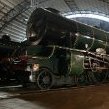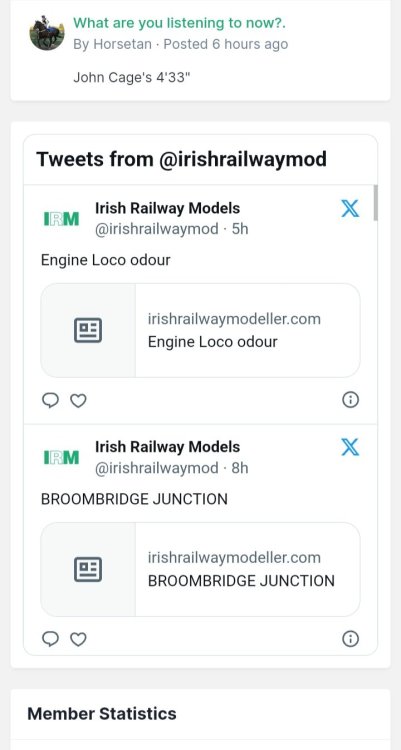-
Posts
1,521 -
Joined
-
Last visited
-
Days Won
4
Content Type
Profiles
Forums
Resource Library
Events
Gallery
Blogs
Store
Community Map
Everything posted by GSR 800
-
"An absolute tub of an engine" Sounds like it could have been a timing issue, combined with being worn out. Milne described her as 'powerful' but in need of excessive repair. My idea would be that she'd be the prototype, and modifications could be made to the production batch to suit. Would need to get to the bottom of this steaming issue. The drawing office at Inchicore studied the work of Chapelons streamlining of steam passages for the 800s, and the result (combined with the massive boiler) was a very free steaming engine.
-
typo for GSWR presumably
-
Any sources for the poor steaming? The issue with running hot was solved by replacing the lightweight motion.
-
800s were 12k a pop, not a clue for 850, nor the NCC locos. the GNRI V class cost just under 6k a pop sans tender, with the SG3s costing just under 9k a pop with tender. I'm unsure of the axle load on the moguls, but on the Jeeps it was 17.8 tons, which was too heavy for the Warrenpoint branch (though the UTA stopped caring about that toward the end). Secondary routes in the Republic seemed to have a limit around 16-17 tons. Innovation does cost money, but modern 'standard' locos with everything being 'get-at-able' as Maunsell would reduce downtime quite a bit, and building locos in bigger numbers brings down cost and maintenance further. Tenders would almost certainly be second-hand on the moguls. If the GSR move toward a policy of shorter, more regular workings they may also bring in more money as they are better able to compete with road traffic. I'll (shockingly) be keeping the 800s for my own alternate timeline. They are built toward the tail end of the GSR at any rate. The problem with electrification, especially OHLE, would be money. It is extremely expensive to build. However I do wonder, considering the Southern (in Britain) was electrifying with third rail, if it could make its way over here? If the 850 can be refined somewhat to iron out the kinks, I think it has the potential to be the Southern Jeep counterpart. Clements and McMahon consider a 2-6-4 based off the Woolwich design as was done in Britain, but rule it out as a go anywhere due to axle load. 850 has an axle load of 16 tons. Even if modifications bring that up to 16.5 or 17 it'd still be quite good.
-
Recently I've been reading through the big green book, and have been considering what might have been. The GSR built few locomotives in its time, and aside from 850 and the 800s, these designs were quite conservative and of questionable use. The GSR was of course, quite a cash strapped company, but nonetheless when pushed could produce powerful, modern, even innovative engines, similar to the GSWR and their 500s. The idea for this is what could have been built or done better with the resources available. The GSR built 5 J15A's and 10 J15B's, the former of extremely conservative design and pretty crap, the latter comparing poorly to the rebuilt J15s they were built to replace. The tank engine version of the 710s were the five 670 tanks, which were considered too slow and outdated. Also built were five 342 class 4-4-0s. Pretty good locos with a light axle load, but again a strangely conservative design with their outside axle frames on the bogie. 850 was a good, powerful locomotive that I think could make a good template for a standard GSR tank locomotive. One of the main issues with it is that she apparently rolled side to side at speed. Presumably this is a topweight issue? Perhaps having the tanks with a section deepened after the motion (akin to LMS practice) could go some way to addressing this? Interestingly, the 820 pacific tank design has deepened tanks, indicating a lesson learned from 850? The 800s, fast, powerful engines, though with quite limited range. I'm thinking the 670s, 700s, 710s and 342s all get thrown out. Whats needed then is a mid-sized, decently powerful tender loco with a light enough axle load (16/17 tons), along with a tank engine for suburban and general working also. If we sort out 850's rolling issue and drop the lightweight motion, we have a template for both the tank locomotives, along with a 2-6-0 mogul version of them. Replacing on a like for like basis, we could end up with 10 moguls and 10 tank locomotives of a modern, useful design for the GSR that can go almost anywhere on the network. My one concern regarding the use of moguls on services is that the Woolwich were apparently overloaded and thus needed to be thrashed on the heavy expresses. A mix of utilising Milne's proposals of shorter trains, and putting some of the 400s out on the heavier Midland trains, at least before they are split at Mullingar/Athlone could go some way to alleviating this, and thus gives more room for the 800s on the Cork line. Clements and McMahon consider the ideal standard loco for Irish railways to have been something along the lines of an Ivatt class 2, designed to exploit the more generous Irish loading gauge. 850 has a very similar tractive effort, adhesion weight, etc, but with bigger cylinders and driving wheels. Thoughts and criticism appreciated.
-
How was loading achieved, lobbed under a grain silo and filled?
-

A 3d printed 800 class for 00 (and a WLWR goods loco)
GSR 800 replied to Killian Keane's topic in Irish Models
Excellent work as always Killian. I am a great believer in the potential for 3d printing, especially for the Irish steam scene. The great challenge for RTR Irish Steam is the sheer variety of classes and variants. This example illustrates the possibilities of bringing these to life and taking full advantage of the ever-widening range of Irish RTR rolling stock coming online. Killian's excellent work shows the level of detail that can be achieved. -
Looks like a lot of the WW1 mass-built tramp steamers, there's a sail vessel there, and the cross channel steamers look to be of 1890s-early 1900s vintage. I would say this is the early 1920s. The 'Melmore head' freighter picked out in the footage was built in 1918, and sunk by a uboat in 1942, so its definitely interwar. If I can pin down the liner in drydock can probably have a near exact date
-
during leaf fall early morning (and possibly late night idk) Enterprises are subbed by ICRs. They are also preferred for winter, as if a loco engine decides its not going to cooperate with cold weather its the train out of action. On an ICR (or any DMU railcar) it has a large degree of redundancy so usually isn't an issue, or can at least limp to terminus.
-
Some horrible lab experiment hybrid jinty USA tank gone wrong?
-

MkIV Refurbishment
GSR 800 replied to 226 Abhann na Suire's topic in What's happening on the network?
AFAIK seats on 29ks aren't being replaced, "all" that's being done is floors, cleaning and replacing graffitied seat backs -

MkIV Refurbishment
GSR 800 replied to 226 Abhann na Suire's topic in What's happening on the network?
29k reflooring is currently underway. Upgrading is always good, IIRC there are no plans to replace the Mark 4s in the near future. I imagine if they are it will be with DEMUs rather than 22ks. I am unsure about the cream colour scheme, new carpeting for the floors would have refreshed the carriages significantly. -
Nothing ridiculous about it. Badly needed additional bike space + standing room, and likely to be added to consists so another car per train.
-
Connolly is going to be at capacity with accelerated Enterprise timetable and Dart +, and Tara Street allows one to travel to Connolly or Pearse within 5-10 minutes in either direction. Link to Drumcondra allows access to services on Cork mainline (hopefully the station at Heuston platform 10 will be completed to facilitate a more cohesive overall network) The sum for the enterprise is quite low, I suspect that may be in part due to any more significant investment in Enterprise services to come when the 201s + DDs are replaced with tri-mode sets. Whatever to be said about the complexity of the Dart + and the power transfer from overheads to batteries, I'm sure a tri-mode will cause no hassle at all....
-
Good excuse to quad track out to Drogheda, which they will need to do anyway whether they want to or not.
-

Inchicore Works traversers & internal shunting
GSR 800 replied to dave182's question in Questions & Answers
shunting on and off traversers is done with a forklift with a coupling attachment these days. Dunno about 80s and 90s- 1 reply
-
- 1
-

-
I agree with much of this, though one must consider the inflationary impact low-interest rates (along with deregulation) have had on upward pressure on residential property markets and cause overall increased inequality as housing detached rapido from the average income. These are more international trends, certainly in the West. Something I find personally interesting, especially given the current debate regarding agriculture across the EU, is NZs approach which would probably be completely unacceptable but has proven productive for agriculture in NZ. What I will disagree on is the omission of Leinster and Connaught as a force to be reckoned with in Rugby!
-
Smokebox, splashers, cab and cab footplate area would need to be replaced completely, and if the tender is hard-wired in, strip out the wiring in the tender and put it into a six-wheeled version. LMS-type tender would need modification itself. New dome if you're picky. I've often thought it 'looks' closer to the 800s with the huge boiler, compared to the Royal Scots, but it seems like it'd be an even bigger job converting it
-
This is simply awful news. Truly a blow to the hobby as a whole. I've dealt with them countless times, their service has always been above and beyond, with perhaps the most reliable postage and best packaging from any company, alongside IRM.
-
Looks excellent so far. The HMS Hood Association is a very useful resource on paint matching, detail differences, and countless other things useful to modellers. I'm planning on getting myself a Flyhawk 1941 Hood sometime soon, but other projects come first! They usually have specific tips for the different models, such as a the poor fitting problems you mention. http://www.hmshood.org.uk/hoodtoday/models/airfix/airfix600.htm My one bit of advice would not be to go 'crazy' on the rust, especially if you intend on modelling her in the 1920s, the crews were kept busy in peacetime keeping her looking well!
-
I've considered Rebuilt Bulleid light pacifics as also being a possible. British loading gauge + 18 ton axle load makes them suitable for all mainline work. (IIRC the loading gauge of the 400s made them unsuitable for the MGWR lines). With tender they were roughly the same length as the 800s. Still I'd imagine turntables would be the bigger gripe with them. Standard 5MTs were great, but axle load is near 20 tons, so maybe the standard 4mt 4-6-0 or 2-6-0 would've been a better fit, or perhaps the standard moguls and 2-6-4 tanks. The 'Mickey Mouse' would've been ideal for branch line work but would've been overloaded (as the Woolwiches were) on heavier trains. With a 'what if' Irish standardisation I think a tint of Bulleid would be great to give uniqueness rather than a copycat of british standardisation. If he had spent more time on standard locos instead of the turf burner we may have ended up with some very interesting designs.
.png.c363cdf5c3fb7955cd92a55eb6dbbae0.png)



